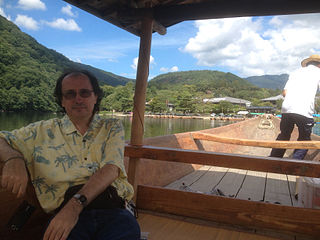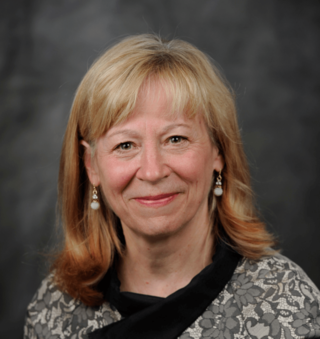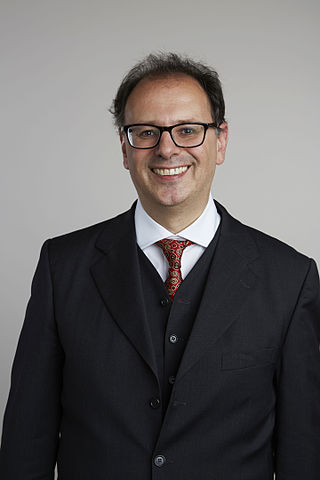
In physics, chemistry, and thermodynamics, an equation of state is a thermodynamic equation relating state variables, which describe the state of matter under a given set of physical conditions, such as pressure, volume, temperature, or internal energy. Most modern equations of state are formulated in the Helmholtz free energy. Equations of state are useful in describing the properties of pure substances and mixtures in liquids, gases, and solid states as well as the state of matter in the interior of stars.

A molecule is a group of two or more atoms held together by attractive forces known as chemical bonds; depending on context, the term may or may not include ions which satisfy this criterion. In quantum physics, organic chemistry, and biochemistry, the distinction from ions is dropped and molecule is often used when referring to polyatomic ions.

In computational chemistry, the Lennard-Jones potential is an intermolecular pair potential. Out of all the intermolecular potentials, the Lennard-Jones potential is probably the one that has been the most extensively studied. It is considered an archetype model for simple yet realistic intermolecular interactions.

Llewellyn Hilleth Thomas was a British physicist and applied mathematician. He is best known for his contributions to atomic and molecular physics and solid-state physics. His key achievements include calculating relativistic effects on the spin-orbit interaction in a hydrogen atom, creating an approximate theory of -body quantum systems, and devising an efficient method for solving tridiagonal system of linear equations.
Benjamin Widom is the Goldwin Smith Professor of Chemistry at Cornell University. His research interests include physical chemistry and statistical mechanics. In 1998, Widom was awarded the Boltzmann Medal "for his illuminating studies of the statistical mechanics of fluids and fluid mixtures and their interfacial properties, especially his clear and general formulation of scaling hypotheses for the equation of state and surface tensions of fluids near critical points."
Tobin Jay Marks is the Vladimir N. Ipatieff Professor of Catalytic Chemistry, Professor of Material Science and Engineering, Professor of Chemical and Biological Engineering, and Professor of Applied Physics at Northwestern University in Evanston, Illinois. Among the themes of his research are synthetic organo-f-element and early-transition metal organometallic chemistry, polymer chemistry, materials chemistry, homogeneous and heterogeneous catalysis, molecule-based photonic materials, superconductivity, metal-organic chemical vapor deposition, and biological aspects of transition metal chemistry.

In thermodynamics, entropy is often associated with the amount of order or disorder in a thermodynamic system. This stems from Rudolf Clausius' 1862 assertion that any thermodynamic process always "admits to being reduced [reduction] to the alteration in some way or another of the arrangement of the constituent parts of the working body" and that internal work associated with these alterations is quantified energetically by a measure of "entropy" change, according to the following differential expression:
Michael W. Deem is an American engineer, scientist, inventor, and entrepreneur. Deem received his B.S. in Chemical Engineering from the California Institute of Technology in 1991 and his Ph.D. in Chemical Engineering from the University of California at Berkeley in 1994. His thesis research was in statistical mechanics and disordered materials with David Chandler. He did postdoctoral research at Harvard University in Physics with David R. Nelson. Deem joined the faculty at University of California, Los Angeles, in 1996 and rose to the rank of Associate Professor of Chemical Engineering. From 2002 to 2020 Deem was the John W. Cox Professor of Biochemical and Genetic Engineering and Professor of Physics & Astronomy at Rice University in Houston, Texas. Deem was the founding director of the Graduate Program in Systems, Synthetic, and Physical Biology at Rice University, 2012-2014. From 2014 to 2017, Deem served as the Chair of the Bioengineering Department at Rice University.
Mark Sheard Child FRS is a British chemist, and Emeritus Fellow of St Edmund Hall, Oxford.
Path integral molecular dynamics (PIMD) is a method of incorporating quantum mechanics into molecular dynamics simulations using Feynman path integrals. In PIMD, one uses the Born–Oppenheimer approximation to separate the wavefunction into a nuclear part and an electronic part. The nuclei are treated quantum mechanically by mapping each quantum nucleus onto a classical system of several fictitious particles connected by springs governed by an effective Hamiltonian, which is derived from Feynman's path integral. The resulting classical system, although complex, can be solved relatively quickly. There are now a number of commonly used condensed matter computer simulation techniques that make use of the path integral formulation including Centroid Molecular Dynamics (CMD), Ring Polymer Molecular Dynamics (RPMD), and the Feynman-Kleinert Quasi-Classical Wigner (FK-QCW) method. The same techniques are also used in path integral Monte Carlo (PIMC).

Piotr Piecuch is a Polish-born American physical chemist. He holds the title of University Distinguished Professor in the Department of Chemistry at Michigan State University, East Lansing, Michigan, United States. He supervises a group, whose research focuses on theoretical and computational chemistry as well as theoretical and computational physics, particularly on the development and applications of many-body methods for accurate quantum calculations for molecular systems and atomic nuclei, including methods based on coupled cluster theory, mathematical methods of chemistry and physics, and theory of intermolecular forces. His group is also responsible for the development of the coupled-cluster computer codes incorporated in the widely used GAMESS (US) package.

Geraldine Lee Richmond is an American chemist and physical chemist who is serving as the Under Secretary of Energy for Science in the US Department of Energy. Richmond was confirmed to her DOE role by the United States Senate on November 5, 2021. Richmond is the Presidential Chair in Science and Professor of Chemistry at the University of Oregon (UO). She conducts fundamental research to understand the chemistry and physics of complex surfaces and interfaces. These understandings are most relevant to energy production, atmospheric chemistry and remediation of the environment. Throughout her career she has worked to increase the number and success of women scientists in the U.S. and in many developing countries in Africa, Asia and South America. Richmond has served as president of the American Association for the Advancement of Science, and she received the 2013 National Medal of Science.

Ali Alavi FRS is a professor of theoretical chemistry in the Department of Chemistry at the University of Cambridge and a Director of the Max Planck Institute for Solid State Research in Stuttgart.

Biman Bagchi is an Indian scientist currently serving as a SERB-DST National Science Chair Professor and Honorary Professor at the Solid State and Structural Chemistry Unit of the Indian Institute of Science. He is a theoretical physical chemist and biophysicist known for his research in the area of statistical mechanics; particularly in the study of phase transition and nucleation, solvation dynamics, mode-coupling theory of electrolyte transport, dynamics of biological macromolecules, protein folding, enzyme kinetics, supercooled liquids and protein hydration layer. He is an elected fellow of the Indian National Science Academy, the Indian Academy of Sciences, The World Academy of Sciences and an International honorary member of the American Academy of Arts and Sciences. Along with several scientific articles, he has authored three books, (i) Molecular Relaxation in Liquids, (ii) Water in Biological and Chemical Processes: From Structure and Dynamics to Function, and (iii) Statistical Mechanics for Chemistry and Materials Science.

William Michael Gelbart is Distinguished Professor of Chemistry and Biochemistry at the University of California, Los Angeles, and a member of the California NanoSystems Institute and the UCLA Molecular Biology Institute. He obtained his Bachelor of Science degree from Harvard University in 1967, his Master's (1968) and PhD (1970) degrees from the University of Chicago, and did postdoctoral work at the University of Paris (1971) and the University of California, Berkeley (1972). After 30 years of research in theoretical physical chemistry, contributing notably to the fields of gas-phase photophysics, optical properties of simple liquids, and the statistical physics of complex fluids, he started a biophysics laboratory with Charles Knobler in 2002 to investigate the physical aspects of viral infectivity.
David Nathan Beratan is an American chemist and physicist, the R.J. Reynolds Professor of Chemistry at Duke University. He has secondary appointments in the departments of Physics and Biochemistry. He is the Director of the Center for Synthesizing Quantum Coherence, a NSF Phase I Center for Chemical Innovation.
Coray Colina is a Professor of Chemistry at the University of Florida.
George Jackson,, , is a British professor of chemical physics in the Department of Chemical Engineering at Imperial College London. He is noted for developing molecular models that describe the thermodynamic properties of complex fluids; as one of the developers of statistical associating fluid theory (SAFT); and for his work in molecular systems engineering. His theoretical work has found a wide range of practical applications in industries such as gas extraction and emerging fields like carbon capture and storage.
Statistical associating fluid theory (SAFT) is a chemical theory, based on perturbation theory, that uses statistical thermodynamics to explain how complex fluids and fluid mixtures form associations through hydrogen bonds. Widely used in industry and academia, it has become a standard approach for describing complex mixtures. Since it was first proposed in 1990, SAFT has been used in a large number of molecular-based equation of state models for describing the Helmholtz energy contribution due to association.
Amparo Galindo is a Spanish chemist who is Professor of Chemical Engineering at Imperial College London. She is the co-director of the Institute for Molecular Science and Engineering. Her research considers the development of statistical mechanics and simulations to understand industrial processes. She was awarded the 2023 Institution of Chemical Engineers Guggenheim Medal.











